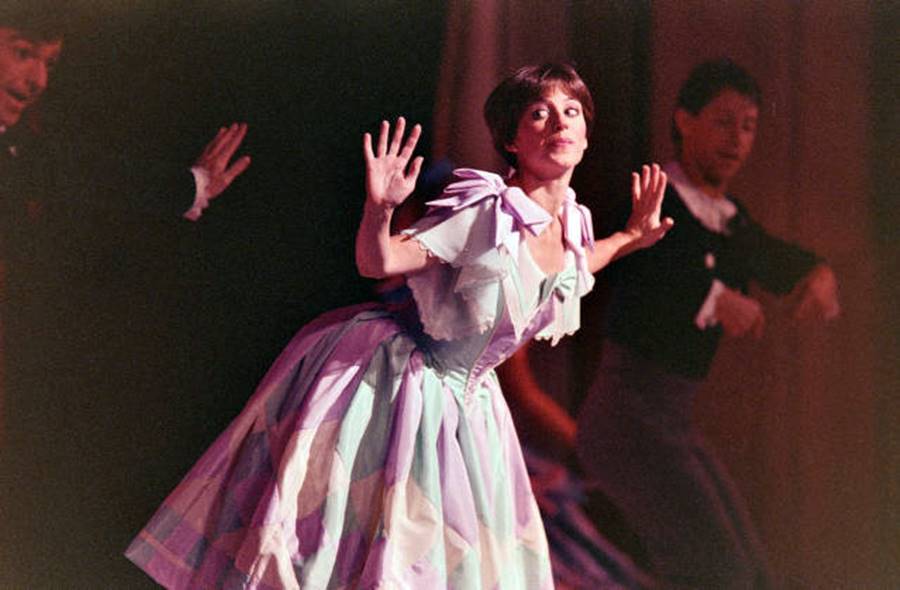
By Jae-Ha Kim
Chicago Sun-Times
November 17, 2003
Leaping and spinning her way through figure-skating routines at the 1976 Winter Olympics, 19-year-old Dorothy Hamill won hearts around the world as she won her prestigious gold medal.
These days, that medal is a reminder to Hamill not of how great she once was, but of how much untapped potential she still has.
Hamill will combine the beauty of ballet with the athleticism of figure skating when she brings her “Nutcracker on Ice” to the Chicago Theatre, 175 N. State, Tuesday through Dec. 2. Hamill’s version will take place on a sheet of ice extending from the rear of the stage to a platform that extends 15 feet into the audience.
She will skate the role of Clara, the young girl who falls in love with a nutcracker prince. The title role will be performed by Nathan Birch. A classic ballet staged by many choreographers, including Mikhail Baryshnikov for the American Ballet Theatre, the “Nutcracker” is a seasonal favorite.
Hamill said the pageantry of the ballet appealed to her as much as the touching story. She’s been eager to tackle the project on ice for several years.
“In the eyes of most people, winning an Olympic medal would be the pinnacle of your life,” Hamill said in a phone interview from Palm Springs, Calif. “But for me, it was just another competition. I know that winning is a dream come true for many people and I don’t want to mislead you into thinking it wasn’t wonderful for me, because it was. But some of my most rewarding moments have been as a pro skater.
“Getting the chance to skate to the `Nutcracker’ is a dream come true for me, too. It’s a story that I’ve really enjoyed since I was a child, and I think every little girl has fantasies about dancing in it. I’m no different.”
This isn’t Hamill’s first pas de deux with ballet on ice. In 1984, Hamill won an Emmy for her portrayal of Juliet in HBO’s production of “Romeo and Juliet.”
Hamill, who has taken ballet lessons since the age of 10, said she enjoys juxtaposing the arts of ballet and figure skating, a combination she finds too rare these days. Figure skating, she said, has evolved into a sport where the execution of difficult moves is valued more than grace and dance ability.
“I look at the things these kids are doing nowadays and I just thank God I don’t have to go head-to-head against them,” said Hamill, 33. “I suppose if I had trained in their time, I would’ve learned those stunts, too.”
Hamill still has a graceful, floating skating style, but most of the stunts she executed during her amateur career wouldn’t cut it in today’s competitions. Now that the precise, but boring, compulsory figures (where skaters have to trace and retrace figure eights) have been eliminated from most major competitions, technical mastery takes a backseat to sheer physical feats.
Skaters such as Japan’s Midori Ito are the sport’s future. Nicknamed the Flying Flea, Ito is short, stocky and aerodynamic. She possesses little of the grace of Hamill or Peggy Fleming. But she can outleap most of her male counterparts, and her daring triple jumps appear to be deceivingly simple.
“Skaters like Midori are wonderful because they add so much to our sport,” Hamill said. “Watching her in action is beautiful. But it’s kind of sad that skaters now are being encouraged to forgo the basics of figure skating to concentrate almost exclusively on how to do these spectacular leaps.”
Skating has been a part of Hamill’s life for 25 years. Born and reared in Riverside, Conn., Hamill won the 1969 National Novice Ladies Championship at the age of 12. Her 37 titles include winning the world championship in 1976 and, of course, the gold medal at the Olympics in Innsbruck, Austria.
After winning the Olympics, Hamill became America’s sweetheart. Clairol developed Short and Sassy, a line of hair products designed to capitalize on Hamill’s trademark wedge haircut, which she still wears a variation of today. A media darling, she appeared on talk shows and TV specials. And the Ice Capades signed her to a lucrative nine-year professional deal.
These days, she works out six hours a day to prime up for her skating tour. When Hamill turned pro at 19, she was lucky if she got one hour of practice in. Besides being detrimental to her skating, her lax workout schedule wreaked havoc on her 5-foot-2, 118-pound frame, which ballooned up to 130 pounds.
“I used to always wonder why a lot of pro skaters ended up doing easier moves on the ice after they quit competition,” Hamill said, laughing. “Then I understood. (The Ice Capades) had me so busy doing press interviews and photo sessions that there was very little time to concentrate on the most important thing: skating. And for me, that was really rough, because all I really knew was skating.
“I remember after winning the Olympics, everybody wanted to interview me and get my views on women’s issues and political matters. That was so difficult for me, because I had technically graduated from high school, but all I really knew about was skating. That’s all I’d ever done for the past 18 years. It’s kind of nice that I may have lost my youth, but I’ve got such a better perspective on the world now than I did back then.”